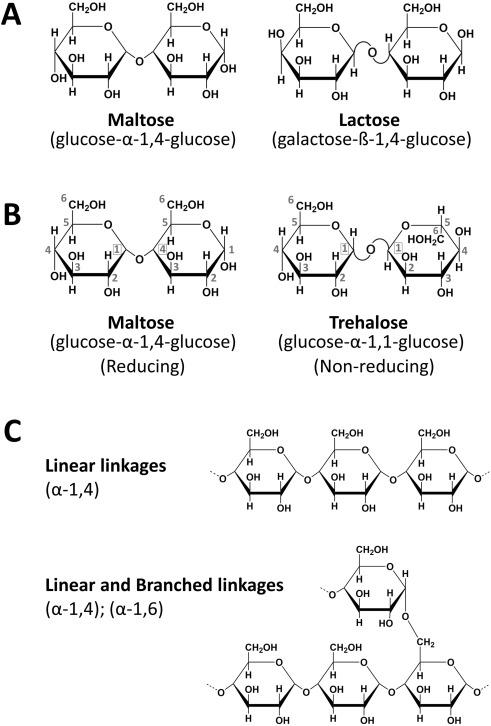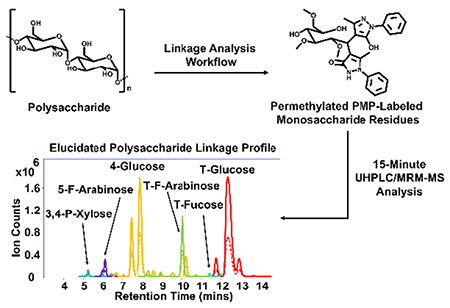Glycan Linkage Analysis Service
- Biomedical research
- Biopharmaceutical quality control
- Biomarker discovery
- Immunology and vaccine development
- Structural biology research
Glycan Linkage Analysis Service is one of the core components of glycomics research, designed to precisely elucidate the linkage patterns and spatial arrangements between monosaccharides, thereby revealing the structural details and functional significance of glycans. This service can be applied in areas such as disease mechanism studies, biomarker discovery, therapeutic glycoprotein quality control, vaccine development, and structural biology.
Glycans are complex carbohydrate structures composed of monosaccharides linked by specific glycosidic bonds, which can be either linear or branched. They are not only essential components of the cell membrane but also play critical roles in signal transduction, cell recognition, immune response, and protein folding. Different glycosidic bond types (such as α1→3, α1→6, β1→4) and branching patterns directly influence the three-dimensional structure and biological function of glycans. Glycan linkage analysis aims to determine the linkage types, positions, and configurations between monosaccharides within the glycan chain, accurately defining branching structures and revealing structural variations of glycans in both healthy and diseased states.

Lim J, Pullicin AJ. Physiol Behav. 2019.
Services at MtoZ Biolabs
Leveraging advanced chromatography, mass spectrometry, and nuclear magnetic resonance (NMR) platforms, MtoZ Biolabs provides Glycan Linkage Analysis Service to determine the linkage positions, bond types, and branching patterns between monosaccharides within glycan chains. MtoZ Biolabs’ service not only delivers comprehensive structural characterization of glycans but also provides valuable data to support the interpretation of their biological functions and subsequent research.
Analysis Workflow
The typical analytical workflow for Glycan Linkage Analysis Service is as follows:
1. Sample Preparation
Release and purify glycans while removing proteins, peptides, and other impurities.
2. Derivatization
Perform methylation or other chemical modifications on glycans to enhance the resolution of structural information.
3. Separation and Analysis
Separate glycans with different structures using methods such as HPLC or capillary electrophoresis (CE).
4. Structural Elucidation
Analyze glycans using high-resolution mass spectrometry (MALDI-TOF MS, ESI-MS/MS) combined with NMR to determine glycosidic linkage positions, types, and branching patterns.
5. Data Integration and Validation
Compare the analytical results with databases and generate a comprehensive report containing information on linkage types, linkage positions, and branching patterns.

Galermo AG. et al. Anal Chem. 2018.
Service Advantages
Multi-platform Integrated Analysis: Combines high-resolution mass spectrometry, NMR and multiple separation techniques to achieve accurate identification of linkage types and positions.
High Resolution and Sensitivity: Capable of detecting low-abundance glycans and distinguishing highly similar linkage isomers.
Flexible Sample Compatibility: Applicable to a wide range of sample types, including serum, tissue, cell culture media, and purified glycoproteins.
From Data to Biological Interpretation: MtoZ Biolabs not only provides structural information but also offers biological context interpretation based on functional and disease relevance.
Sample Submission Suggestions
Sample Types
Accepts a wide range of samples, including purified glycans, glycoproteins, tissue extracts, and cell lysates.
Storage and Transportation
Samples should be stored at low temperature (≤ -20°C). Ship on dry ice. Avoid repeated freeze-thaw cycles.
It is recommended to contact the MtoZ Biolabs technical team prior to sample submission to obtain detailed and tailored guidelines for sample preparation and submission.
Applications
Examples of applications for Glycan Linkage Analysis Service:
Reveal disease-associated glycan structural changes to support studies on the mechanisms of cancer, immune disorders, and metabolic diseases.
Assess the consistency and stability of therapeutic glycoprotein glycans to ensure drug safety and efficacy.
Compare glycan linkage patterns between healthy and diseased samples to identify highly specific diagnostic or prognostic biomarkers.
Analyze glycan epitopes recognized by the immune system to guide the design of vaccines targeting specific glycan structures.
Facilitate the elucidation of three-dimensional glycan conformations in protein complexes, on cell surfaces, and in pathogen envelopes.
Deliverables
1. Comprehensive Experimental Details
2. Materials, Instruments, and Methods
3. Total Ion Chromatogram & Quality Control Assessment (project-dependent)
4. Data Analysis, Preprocessing, and Estimation (project-dependent)
5. Bioinformatics Analysis
6. Raw Data Files
Related Services
Glycan Linkage Position Analysis Service
How to order?







